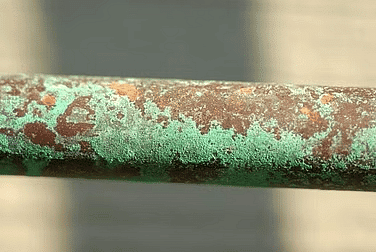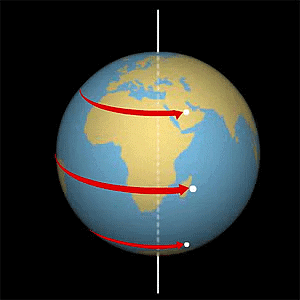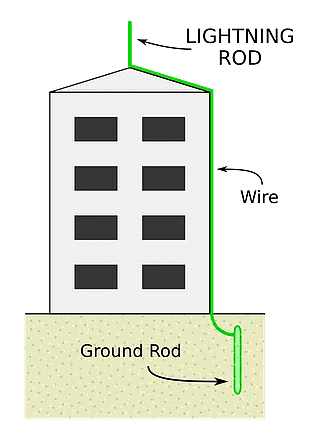SSC CGL Exam > SSC CGL Notes > SSC CGL Tier 2 - Study Material, Online Tests, Previous Year > Scientific Explanations of Common Phenomena
Scientific Explanations of Common Phenomena | SSC CGL Tier 2 - Study Material, Online Tests, Previous Year PDF Download
- It is dangerous to sleep in an unventilated room with fire burning inside because the fire produces carbon monoxide and carbon dioxide gases. Carbon monoxide is poisonous and can cause death.
- The filament of an electric bulb is made of tungsten because it has a high melting point and can be heated to a high temperature to emit light.
- Water kept in an earthen pitcher becomes cold because the pitcher has minute pores on its surface which absorb water. Water in the pores evaporates when it comes in contact with air, and produces a cooling effect.
- A sliced apple, when exposed to air, turns brown after some time as it contains iron which gets oxidised and gives the fruit a brownish colour.
- The freezing compartment inside a refrigerator is at the top because the air in contact with it becomes cold and heavy and sinks downwards, cooling the rest of the compartment.
- A copper vessel left in the air for a long time turns green. This is due to the formation of copper carbonate when copper reacts with carbon dioxide and moisture present in the air.
 Formation of Copper Carbonate on pipe
Formation of Copper Carbonate on pipe - A wick in a stove keeps burning continuously as kerosene rises in the wick due to capillary action.
- The Earth rotates on its axis from west to east. This rotation makes the Sun and the stars appear to be moving across the sky from east to west.
 Earth rotation on its axis
Earth rotation on its axis - The sky appears blue because the light of the Sun is spread or scattered by the dust particles in the air. In space the sky would appear black as there are no dust or air particles to scatter the light.
- Food is cooked quickly in a pressure cooker because of boiling point of water increases at high pressure. Food cooks faster at high temperature.
- In mountainous regions, the atmospheric pressure is less than it is at sea level. Water, therefore, boils at a lower temperature (less than 100 degree Celsius) and food takes more time to cook.
- When ice floating in a glass of water melts, the level of water remains unchanged because as a solid, ice displaces an equal volume of water.
- A man weighs more at the poles then at the equator because the polar radius of the Earth is less than the equatorial radius. Hence the gravitational pull is more at the poles than at the equator.
- Standing in double-decker buses, particularly on the upper floor, is not allowed because on tilting, the centre of gravity of the bus gets changed it is likely to overturn.
- The boiling point of seawater will be more than the boiling point of pure water because the former contains salt and other impurities.
- An ordinary clock loses time in summer because the length of its pendulum increases, and therefore, its time period also increases. The pendulum takes more time to complete each oscillation and thus loses time.
- Whenever there is water loss from the body, secretion of saliva is reduced resulting in dryness of the mouth and stimulating the sensation of thirst. Intake of fluid then helps in restoring the loss of the body.
- A swimmer just out of the river feels cold particularly if it is windy, because of the evaporation of water from his body surface. The evaporation is more on a windy day.
- Alcohol is sometimes rubbed on the body of a person suffering from fever. As soon as it is applied on the body, it evaporated taking away some heat from the body. Since evaporation has a cooling effect, the body temperature can be reduced by rubbing alcohol.
- Soft iron is used as an electromagnet because it remains a magnet only while the current passes through the coil around it and loses its magnetism when the current is switched off.
- The person jumping out of a moving train is carried forward in the direction of the train because the person himself is in motion sharing the velocity of the train and will continue in its state of uniform motion unless it exercises some force to prevent it (Newton’s first law of motion).
- A lightning conductor is fixed to all buildings to protect them from the destructive effects of the lightning.
 Working of lightning conductor
Working of lightning conductor - An electric bulb makes a bang when it is broken because there is a vacuum inside the electric bulb; when the bulb is broken air rushes in at great speed from all sides to fill the vacuum. The rushing of air produces a noise generally referred to as the “bang”.
- A small space is left between each set of two rails of railway line to allow for their expansion in summer.
- A bad egg floats in water because the up-thrust produced on account of displaced water by the immersed portion of the bad egg is greater than the weight of the egg.
- Moisture gathers on the outer surface of a glass tumbler containing cold water because the water vapours present in the air get cooled and appear as droplets of water on coming in contact with the cold surface of the glass tumbler.
- The launching of Earth satellites should be from a place near the equator to take the fullest advantage of the Earth’s movements. The regions of the Earth closer to the equator are moving faster through space as compared to regions elsewhere. Thus at the equator, rockets would start off with a speed of nearly 1600 km/hour. Father, rockets are usually fired in the direction of the Earth’s rotation.
- In deserts, day temperatures are very high and night temperature are extremely low because the specific heat of sand is very low. It; therefore, absorbs the heat readily and its temperature rises by a large degree during the day. At night sand radiates the heat equally readily, making the temperature low.
- If you are sweating; you will feel cooler on a hot day than on a cooler moist day because on a hot dry day the perspiration gets evaporated quickly producing more cooling effect.
- The air escaping from a punctured tyre feels cold because the air escaping from a punctured tyre enters a region of low pressure from high pressure and thus suffers a fall in temperature.
- White roof keeps the house cooler in summer than black roof because white roof reflects more and absorbs less heat whereas black roof absorbs more and reflects less heat rays.
- It is hotter on a cloudy night than on a clear night because clouds prevent the heat radiated by the Earth from escaping into the sky.
- Ice wrapped in a blanket does not melt away quickly because woollen blanket is a bad conductor of heat.
- A rose appears red when day light falls on it because it absorbs all the constituent colours of white light except red, which it reflects to us.
- Grass appears dark in blue light because it has the property of absorbing all other colours except its own colour. The blue rays falling on the grass are absorbed by it and hence it appears dark in colour
- A group of soldiers on a bridge are advised not to walk in steps because their movement causes the bridge to vibrate. It they walk in step the frequency of vibration may match the natural frequency of the bridge structure, thereby causing resonance. This resonance of frequency can cause the bridge to collapse.
- When the wind is blowing at high speed, the roofs of the hutments are sometime blown away. The pressure at the top falls much below the pressure below the roof. This difference in pressure across the roof causes it to be blown away.
- Human breath is visible in winter but not in summer because in winter air is cold and so water vapours present in the human breath condense, making it visible.
- Steam causes more severe burn than boiling water because steam at the same temperature has more latent heat which causes more severe burns than boiling water at the same temperature.
- It is not advisable to wash a clinical thermometer with boiling water because the boiling point of water is much is much above the maximum provided in the clinical thermometer. As a result, pressure from undue expansion of mercury may break it.
- The face turns red when one feels hot and turns blue when one feels cold. This is because in the first case the blood rushes towards the skin to get cooled, and in the second case it rushes away from the skin to keep itself warm.
- A petrol fire cannot be extinguished by pouring water over it because of the high temperature of burning petrol the water breaks up into hydrogen and oxygen which only helps in burning. Further, petrol being lighter than water, floats on water and continues to burn
- We experience difficulty in breathing on mountains because the pressure of the air outside is less as compared to the pressure of air inside the lungs.
- If a highly corked glass bottle full of water is left out of doors on a frosty night it will burst because the water contained in the bottle will freeze on a frosty night and convert into ice. There is no room available for the increased volume and this may result in bursting of the bottle.
- Water extinguishes fire because as it evaporates, the temperature of the burning body is lowered, thus retarding or stopping the burning action. Also the resulting vapour surrounds the burning substance cutting off the oxygen supply thus inhibiting the burning process. In fact, hot water will extinguish fire more quickly than cold water as hot water will vaporise faster.
- A perspiring man feels relief when air floats by his side because the flow of air increases the rate of evaporation of perspiration from the body.
- Water from a hand pump is warm in winter and cold in summer because in winter outside temperature is low and in summer outside temperature is higher as compared to the temperature of water obtained from underground which remains practically unchanged due to Earth being bad conductor of heat.
- A thick glass tumbler often cracks when very hot liquid is poured into it because the inner surface of the thick glass tumbler coming in contact with the hot liquid expand more in comparison with the outer surface which has relatively lower temperature. This unequal expansion of inner and outer surface causes the tumbler to crack.
- When a gun is fired at a visible distance, the sound is hears a little after the smokes is seen because the velocity of light is much higher than that of sound.
- A train stops when the chain pulled because of the following mechanism.
- When the chain is pulled, one small valve gets opened and air enters to the underside of the piston head of the brake cylinder through pipe connections.
- Initially there is vacuum on both top and bottom side of the piston head.
- When air enters the underside of the piston head, the piston raises up due to difference of pressure and pulls the brake thus stopping the train.
The document Scientific Explanations of Common Phenomena | SSC CGL Tier 2 - Study Material, Online Tests, Previous Year is a part of the SSC CGL Course SSC CGL Tier 2 - Study Material, Online Tests, Previous Year.
All you need of SSC CGL at this link: SSC CGL
|
1335 videos|1437 docs|834 tests
|
FAQs on Scientific Explanations of Common Phenomena - SSC CGL Tier 2 - Study Material, Online Tests, Previous Year
| 1. What is the scientific explanation for the phenomenon of lightning? |  |
Ans. Lightning is a natural electrical discharge that occurs during thunderstorms. It is caused by the separation of positive and negative charges within a thundercloud. When the charge separation becomes strong enough, a pathway is formed for the electrical current to flow, resulting in a lightning bolt.
| 2. How does the scientific explanation for the phenomenon of rain relate to the water cycle? |  |
Ans. Rain is a result of the water cycle, which is a continuous process of evaporation, condensation, and precipitation. When water evaporates from bodies of water and land surfaces, it rises into the atmosphere where it cools and condenses into clouds. Eventually, the condensed water droplets combine and become heavy enough to fall as rain.
| 3. What scientific explanation can be given for the phenomenon of tides? |  |
Ans. Tides are caused by the gravitational pull of the moon and the sun on Earth's oceans. The moon's gravitational force is stronger than the sun's, which causes the ocean to bulge towards the moon, creating a high tide. As the Earth rotates, different parts of the planet experience high and low tides due to the changing positions of the moon and the sun.
| 4. How can the scientific phenomenon of refraction explain the bending of light when it passes through different mediums? |  |
Ans. Refraction is the bending of light as it passes from one medium to another. This phenomenon occurs because light travels at different speeds in different mediums. When light enters a medium with a different optical density, such as air to water, it changes direction due to the change in speed. This bending of light is responsible for various optical illusions and the appearance of objects in different positions.
| 5. What is the scientific explanation behind the phenomenon of earthquakes? |  |
Ans. Earthquakes occur due to the sudden release of energy in the Earth's crust, resulting in seismic waves. This release of energy is usually caused by the movement of tectonic plates, which are large pieces of the Earth's lithosphere. When these plates collide, slide past each other, or pull apart, they generate seismic waves that cause the ground to shake.
Related Searches





















